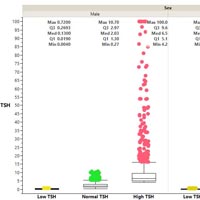Prevalence of thyroid dysfunctions in a large, unselected population in Duhok city, Iraqi Kurdistan: A cross-sectional study

Accepted: November 21, 2021
All claims expressed in this article are solely those of the authors and do not necessarily represent those of their affiliated organizations, or those of the publisher, the editors and the reviewers. Any product that may be evaluated in this article or claim that may be made by its manufacturer is not guaranteed or endorsed by the publisher.
Authors
This study aimed to determine the prevalence of Thyroid- Stimulating Hormone (TSH) alterations and different types of thyroid dysfunctions in both sexes with no age limitations from variety of sources in Duhok province. In this retrospective cross-sectional study, we screened 25040 suspicious cases of thyroid diseases in a year (2019), retrieving the data from the computers of three clinical laboratories of Duhok City. Following exclusion of 470 cases, 24568 cases were included to categorize the different types of thyroid dysfunctions. The prevalence of TSH alteration was 25.03%, 20.55% of them had a high concentration being statistically higher in females, while only 4.48% was low TSH with equal prevalence among both sexes. Out of 24568 patients, the prevalence of subclinical hypothyroidism was 94.85%, followed by 2.20%, 1.20%, 0.78%, 0.67%, and 0.31% for each of subclinical hyperthyroidism, primary hypothyroidism, central hyperthyroidism, central hypothyroidism, and primary hyperthyroidism respectively. In conclusion, the studied population had high prevalence of high TSH level (20.55%), being more prevalent in female than in male. Our survey revealed that the distribution of thyroid disorders varied among different age groups with highest prevalence of subclinical hypothyroidism in all age groups (94.85%). We also concluded that middle and advanced ages, and females were more susceptible to thyroid disorders.
How to Cite
PAGEPress has chosen to apply the Creative Commons Attribution NonCommercial 4.0 International License (CC BY-NC 4.0) to all manuscripts to be published.

 https://doi.org/10.4081/jbr.2021.10067
https://doi.org/10.4081/jbr.2021.10067



